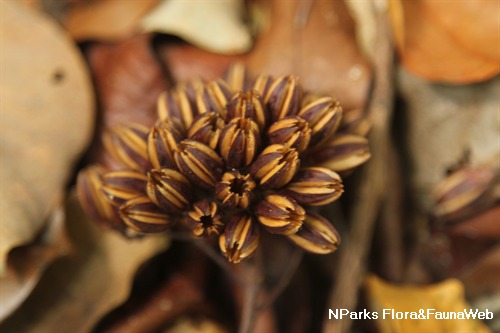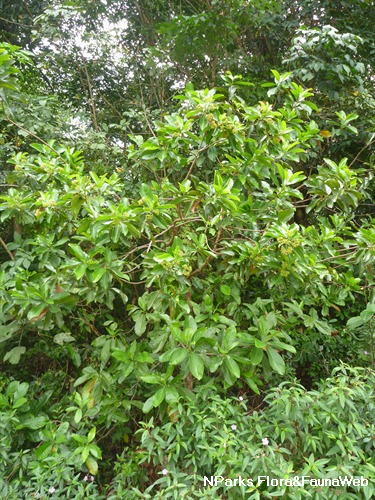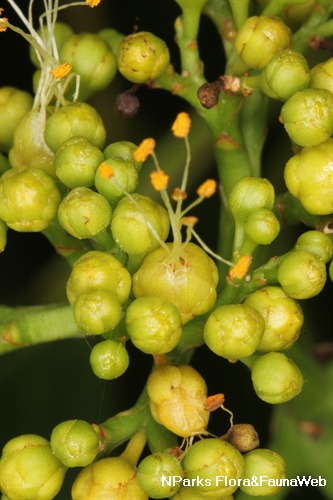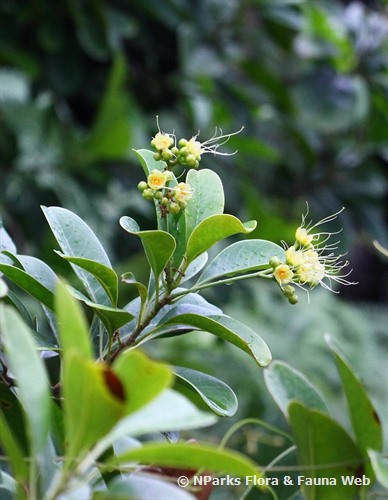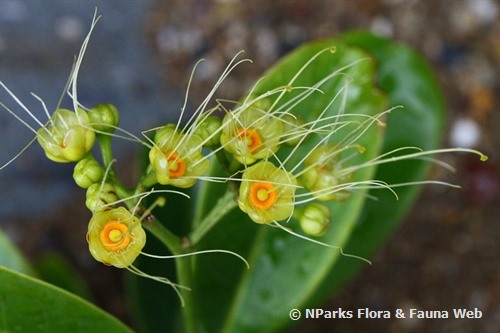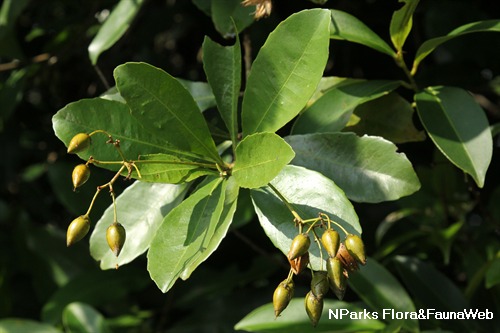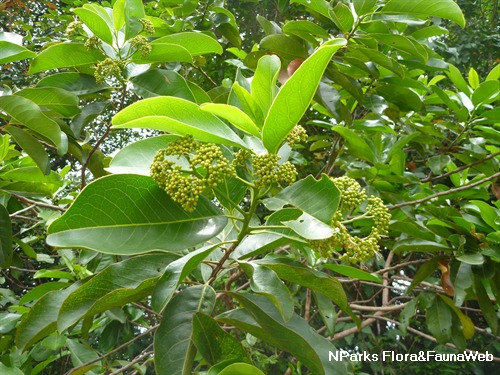
Back
Ixonanthes reticulata Jack
| Family Name: | Ixonanthaceae |
| Common Name: | Pagar Anak, Ten Men Tree, Inggir Burong, Nyiran Burong, 粘木 |
Name
Classifications and Characteristics
| Plant Division | Angiosperms (Flowering Seed Plants) (Dicotyledon) |
|---|---|
| Plant Growth Form | Tree (Big (>30m)) |
| Lifespan (in Singapore) | Perennial |
| Mode of Nutrition | Autotrophic |
| Plant Shape | Irregular |
| Maximum Height | 40 m |
Biogeography
| Native Distribution | India, Myanmar, Vietnam, South China, Sumatra, Peninsular Malaysia, Singapore, the Philippines, Sulawesi, Borneo, and New Guinea |
|---|---|
| Native Habitat | Terrestrial (Primary Rainforest, Secondary Rainforest, Freshwater Swamp Forest) |
| Preferred Climate Zone | Tropical, Sub-Tropical / Monsoonal |
| Local Conservation Status | Native to Singapore (Least Concern (LC)) |
Description and Ethnobotany
| Growth Form | It is a tree up to 40 m tall, with narrow buttresses at the base. Gaping wounds are found on the bark around the buttresses. |
|---|---|
| Foliage | Its spirally arranged, stalked leaves have thickly leathery leaf blades that are usually oval, entire, and 5.5–14 by 3–10 cm, with distinct, net-like, intercostal veins. They have blunt or notched apices. |
| Flowers | Its flowers are covered with resin, and found in long-stalked, loose clusters from the leaf axils. The flowers are white or greenish, and 3–5.5 by 2–7 mm when in full bloom. |
| Fruit | Its woody fruits are up to 2–4.5 cm long and not divided into two halfway from the tips. The ripe fruits split into 5 parts from the top to bottom to reveal seeds that are 18–20 by 4–9 mm and basally winged. |
| Habitat | It grows in primary and secondary forests on hillsides and ridges, and swamp forests, from sea-level to 2,400 m altitude. It occurs locally along Mandai Road, in Bukit Timah Nature Reserve, and the vicinity of Sentosa (Mount Imbiah). |
| Associated Fauna | Its flowers are insect-pollinated. |
| Cultivation | It can be propagated by seed. |
| Etymology | Greek ixos, birdlime; Greek anthos, flower, referring to the sticky flowers; Latin reticulatus, net-like, referring to the venation of the leaf blades |
| Ethnobotanical Uses | Timber & Products: The timber is used as firewood, and in minor construction. |
Landscaping Features
| Landscaping | It is suitable for parks. |
|---|---|
| Landscape Uses | General, Parks & Gardens, Riverine |
Fauna, Pollination and Dispersal
| Pollination Method(s) | Biotic (Fauna) |
|---|---|
| Seed or Spore Dispersal | Abiotic |
Plant Care and Propagation
| Light Preference | Full Sun, Semi-Shade |
|---|---|
| Water Preference | Lots of Water, Moderate Water |
| Plant Growth Rate | Fast, Moderate |
| Rootzone Tolerance | Moist Soils, Waterlogged Soils (Drains Site), Well-Drained Soils, Fertile Loamy Soils |
| Maintenance Requirements | Moderate |
| Propagation Method | Seed |
Foliar
| Foliage Retention | Evergreen |
|---|---|
| Mature Foliage Colour(s) | Green |
| Mature Foliage Texture(s) | Leathery, Thick |
| Foliar Type | Simple / Unifoliate |
| Foliar Arrangement Along Stem | Alternate, Spiral |
| Foliar Attachment to Stem | Petiolate |
| Foliar Shape(s) | Non-Palm Foliage (Oval) |
| Foliar Venation | Pinnate / Net |
| Foliar Margin | Entire |
Floral (Angiosperm)
| Flower & Plant Sexuality | Bisexual Flowers |
| Flower Colour(s) | White, Green - Light Green |
|---|---|
| Flower Grouping | Cluster / Inflorescence |
| Flower Location | Axillary |
Fruit, Seed and Spore
| Mature Fruit Colour(s) | Brown, Black |
|---|---|
| Fruit Classification | Simple Fruit |
| Fruit Type | Dehiscent Dry Fruit , Capsule |
Image Repository
Others
| Master ID | 1942 |
|---|---|
| Species ID | 3234 |
| Flora Disclaimer | The information in this website has been compiled from reliable sources, such as reference works on medicinal plants. It is not a substitute for medical advice or treatment and NParks does not purport to provide any medical advice. Readers should always consult his/her physician before using or consuming a plant for medicinal purposes. |

